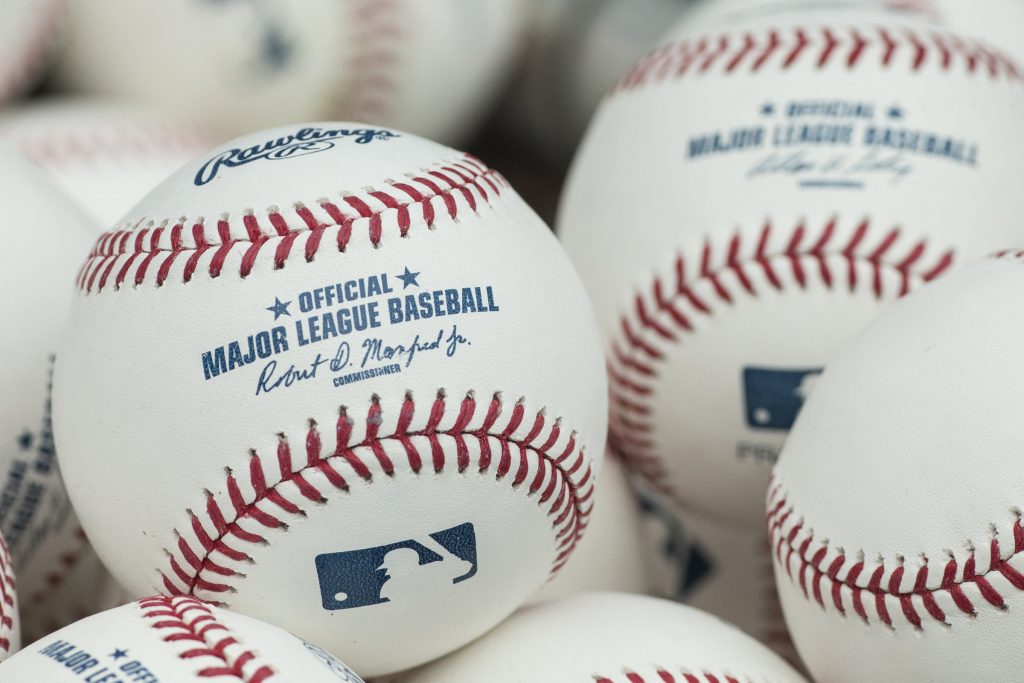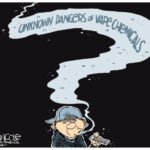Is this where the game is heading, and are we all really OK with this:
He knew this ball was GONE 😤 @BRWalkoff
(via @wbu_baseball, @KingOzunaV) pic.twitter.com/TaYOEk9O88
— Bleacher Report (@BleacherReport) May 9, 2021
I’m probably going to write a lot about this subject in this post, but I guarantee you one thing: I’m not here to answer the above question. It’s not some rhetorical musing on my part. I don’t know the answer. And even if I did, I couldn’t answer it myself. I have too much respect for the game to even try.
What I do know is that this video of a home run celebration has been circulating on social media over the weekend, and the hot takes have been flying on both sides. From some younger fans who want much, much more of this in baseball. To some older ones who think something like this is an affront to the way the game should be played.
I’ll tell you the truth: I’m all for more emotion in the game. I want players to express themselves in a way that makes them more relatable to fans, and not less; more of an example of how much you can love the game, how much your time on the field is valued, how much it means to you as a player. Because that sort of stuff is what attracts young men and women to the game. And that’s not just baseball. That’s every sport.
But this whole thing still bothers me.
I will try, as we move along, to explain that feeling in greater detail. But really, this post shouldn’t be seen as an in-depth breakdown of one young man’s trip around the bases. It’s a look at where the game is as a whole, and where it’s going, and whether it should go there, and what it means for my generation to pass the game off to the next one.
And whether that’s really a good thing.
Some context
So, I had to do some digging on this for some reason, but I thought it was important to do the work. And, truthfully, it was.
Who is that sweet-swinging slugger? What did that game mean? Was that just one home run in a vacuum? Was there something more behind the celebration?
His name is Gregory Ozuna. He’s a shortstop at Wayland Baptist University, an NAIA program in Wayland, Texas. An argument can be made that he’s the best player in the Sooner Athletic Conference, too.
There are some things the video above doesn’t tell you about Ozuna or that swing.
First, this is a playoff game, and Wayland was hardly the favorite. The Pioneers were 25-23 heading into the game, a sixth-seed trying to stave off elimination, against a team that swept them in the regular season. They were also trailing 7-0 after a disastrous first and 8-0 after 2. But they fought back with five runs in the third and five more in the sixth, and the pitching kept them close enough to be within a run, 12-11, heading into the ninth.
There was a runner on and two out when Ozuna came to the plate. The batter before him, with one out and a runner on first, hit a slow roller to shortstop that the Oklahoma City shortstop bobbled just a bit, enabling them to get just the lead runner out at second. That one little foible may have kept the game alive for Ozuna.
So, in absolute fairness, on the “situations that could yield a raucous celebration” scale, this moment ranked pretty high.
Something else the video doesn’t show you: Ozuna was ejected before he ever reached first base. The home plate umpire was nearly hit with the bat when Ozuna threw it back — not fair to call it a bat flip, because he just turned and fired it toward…someone — and the ump chucked him from the game immediately. The game was actually delayed about four minutes while the umpires tried to calm the situation and decipher whether the run should have been allowed to score (which, they determined correctly, at least according to the major league baseball rule, he should).
Not to try to operate Ozuna’s mind, because who knows. But I don’t think he intentionally threw the bat at the umpire. Ump was walking out to where he needed to be to make sure the runners touched the plate. Ozuna threw the bat where he did, and they kind of just ended up in the same vicinity. The ejection was warranted because when you do something like that and someone can possibly get hurt, you’re taking that risk. But I don’t think there was any intent to potentially injure the umpire or even send a message to him. Ozuna, after all, hit the first pitch of the at-bat out, so it wasn’t like there was a blown strike call. And I didn’t notice another missed call that he obviously had a problem with earlier.
*Incidentally, if you want to watch the entire game, here’s the link. It was pretty wild.
Some perspective
This is a tough one. As over-the-top as all of that looked, Ozuna never seemed to say anything to the pitcher. Never had a staredown with an opposing infielder. Didn’t shout anything into the Oklahoma City dugout. Didn’t slow trot around the bases. The jump on home plate with the team yelling “Boom!” as he landed, 1.) is something they did on a few other home runs in the game, so it’s clearly a ritual for the team, and 2.) is an entertaining team celebration, something for fans to look forward to — and, yes, for opposing fans to despise — after home runs. Baseball needs MORE of that.
But remember Supreme Court justice Potter Stewart’s famous definition of obscenity?: “I know it when I see it.” That’s kind of how I feel about this one. Something just doesn’t sit right, and I don’t know how exactly to explain most of it. The bat throw is easy enough: That can injure someone. The umpire was in the area, obviously. So was the catcher. Perhaps the on-deck hitter too. Show all the emotion in the world, but you can’t put someone else at risk by doing it.
Shows of emotion are something baseball needs. I know this because we hear this every day from younger fans who for some reason are enthralled by the metrics of the ball hit into play and the one blown past a hitter out of the pitcher’s hand. They seem to find copious amounts of entertainment from bat flips, and I’ll be honest, I don’t get that. It’s not my thing, watching the bat twirl in the air after someone hits a home run. If it’s your thing, great. I don’t see how that’s remotely entertaining, why someone is going to pay $50 to get into a major league game to salivate over that. But I also don’t lose any sleep over them, either.
I just think there’s a big difference between showmanship and emotion. And that difference is something this particular highlight of a home run in an NAIA game has really got me thinking about.
Some honesty
Someone once told me, I apologize because I forget exactly who, that boring people find baseball boring.
I totally think that’s the case. There’s a beauty to this game that I never saw in others. I always appreciated the fact that you could help the team by getting yourself out, with a well-placed bunt or by looking for a pitch you can hit on the ground to advance a runner in a big situation. They call it a sacrifice, and there’s nothing better you can do for your team than sacrifice.
It doesn’t have to be played the way it always was. I’m not a big “unwritten rules” guy. But I was always taught to be a “respect your opponent and the game” kind of person, too.
Let me take you back almost 26 years, to a game that I watched live at the time and happened to watch again on DVD a few days ago with my 9-year-old son. Because the way the game is played today, I can’t go too long without watching Don Mattingly play baseball without losing my mind.
It was Game 2 of the 1995 ALDS between the Mariners and Yankees at Yankee Stadium. There were two moments from the bottom of the sixth inning that really stood out to me, watching the broadcast of that game all these years later.
First, the Ruben Sierra home run trot. Which, can you imagine that being a thing today? We’ve actually come a long, LONG way when it comes to understanding that ballplayers aren’t robots. Some outward emotion when you do something good is not a bad thing, and celebrating a big moment with your team is never a bad thing.
To think both announcers thought Sierra’s trip around the bases — in the moments after he tied a playoff game in the major leagues — was notable and worth mentioning is kind of eye-opening today.
But the Mattingly home run that followed is the one I want to focus on a bit, because it was as emotional a moment as you’ll ever see in sports. And I’m not talking about a moment just for fans, who waited 13 years to see the Captain in a playoff game, and there he was, hitting a go-ahead home run.
Players who were there that night will tell you that was the loudest they had ever heard Yankee Stadium, that it ranks among the most emotional moments they had every experienced on a ball field. Mattingly didn’t go into a home run trot. Didn’t do a bat flip. And yet, I think you can see the emotion out of him as he rounded the bases. You could see what that moment meant to the guy. He said he always wanted to play in one playoff series, just to see if he could rise to the occasion. And he did.
Is that “boring?”
Should he have tried a bat flip there? Would that have made you, as a fan, feel more into that moment?
Should he have yelled and screamed as he rounded the bases? Should he have found a camera and pointed into it? Should he have flexed his biceps? Should he have jumped with both feet onto home plate? What? What would have made that moment any better, any more timeless? I’ll never not get goosebumps thinking of that home run, never mind watching it.
And let’s be real here: “Showing emotion” has always been part of the game. Kirk Gibson pumping his arm as he ran around the bases at Dodger Stadium. The Carlton Fisk homer in 1975? Joe Carter’s in 1993? Derek Jeter after the Mr. November homer in 2001? Any of Reggie Jackson’s in 1977? Dennis Eckersley after he struck out…anybody, ever?
Emotion has always been part of the game. It’s the open trash-talking, taunting, desperate spotlight grabs that haven’t been. So when anyone says “the game is boring, it needs more emotion,” I tend to see through that and conclude that what they really want more of is the trash-talking, taunting, and things of that nature.
Does that make the game more interesting? Indisputably.
Does it make it better? Is it what we really want? Those are better questions.
Some things to consider
What we have here is more than just one home run celebration, in fairness to and with no offense intended for Gregory Ozuna, This is just a really good example of the chasm between the game’s past and what many younger fans would like to see for the future.
Former major league second baseman Jeff Frye has long been one of my favorite follows on Twitter, mostly because I really liked the way he played the game during his career. He was a clutch hitter, could play multiple positions, give you really good at-bats consistently, didn’t strike out a ton…my kind of player, anybody who knows me will tell you. He was 5-foot-9, and told a million times by a million different people in the game he’d never make it, and he ended up spending eight years in the bigs.
But, he also calls out a lot of garbage. Like, the over-emphasis on metrics. Bad umpiring. The “strikeouts aren’t bad” culture. Mostly, gimmick devices and techniques “hitting gurus” are trying to sell off to young players and unsuspecting parents as a “must-have” tool to get better. He’s a pronounced critic of the launch-angle swing and the youth travel showcases that, trust me, are way more a money-grab at the higher levels than many parents choose to believe.
It’s not him alone, either. He has been at the heart of what he calls the #shegone movement on Twitter, but plenty of really good players and better people who love the game that I’ve met throughout my career covering baseball — from big leaguers to career minor leaguers to scouts — back the guy.
He also is the one who first called out the Ozuna home run trot.
This makes me sad! We haven’t taught this generation how to behave on a baseball field. This is what we get. “Let the kids play” isn’t the message we should be sending obviously. #shegone @notgaetti @BobFile @twuench @RickWrona @GDBJr5 pic.twitter.com/qRye9RAcZF
— Jeff frye/ #shegone (@O3jfrye) May 9, 2021
I’ll let you read the responses to Jeff’s post. Many of them, I wouldn’t be able to post on a family sports blog. Basically it’s “pitcher doesn’t want to get shown up, throw a better pitch,” or “what’s wrong with celebrating,” or “young people aren’t watching baseball because it lacks passion.”
Let me address each of these quickly:
1.) Throw a better pitch? OK, but let’s be fair about that. A lot of hitters these days are up there swinging for the fences. Every swing. No matter the situation. No matter the count. Is hitting a home run somehow so impressive, when it’s your only goal in life at that moment, that you get to do whatever you want in the aftermath of actually accomplishing it once out of every 15-20 at-bats?
2.) What’s wrong with celebrating? Nothing! And most of what he did would constitute a pure celebration. But what’s wrong with throwing the bat recklessly toward an umpire and a catcher, staring into the camera, drawing attention to yourself? A good argument can be made that things like that are what legitimately raises the ire of the opposing team and leads, ultimately, to some of the things baseball doesn’t want.
3.) Young people aren’t watching baseball because it lacks passion? But…does it lack passion? You typically don’t have to look hard to find passionate players these days, and you honestly never did. But we shouldn’t confuse passion for contrived drama and needless controversy. Which, again, I think is what some fans want more of these days than true shows of emotion and passion. And, perhaps, not just in baseball.
I think there’s middle ground to be found on these issues, but neither side wants to concede any ground to the other. Frye and the older baseball people want to go back to the days when the unwritten rules were king, and they aren’t going to cave to a new generation of fans who, quite frankly, have minimized their accomplishments by arguing that metrically speaking, they wouldn’t be able to even compete as major leaguers in todays game.
They’re treaded like the game doesn’t want them, or need them, anymore.
And honestly, the game needs help. If it hasn’t lost its way, it is veering off track. Math majors preaching about the “three true outcomes” are making the game fairly unwatchable. There are more non-contact at-bats, and less hits, than ever before. The young fans will tell you that’s because pitchers throw harder than at any point in history (and on the whole, they’re probably right). But there have been four (really, five) no-hitters pitched this season. The last one was by Reds lefty Wade Miley, who has a career ERA over 4 and a fastball that averages less than 90 mph.
Pitching is getting better, as the approach to hitting those pitches is as bad as it has ever been.
This past weekend, the Yankees played three games against the Washington Nationals. On Saturday and Sunday combined, the Yankees didn’t make contact in 52.6 percent of their plate appearances. They won both games.
For the weekend, 40 percent of the players that came to the plate walked away from it without putting the ball in play.
Those are mind-boggling numbers. It’s a sign that there just isn’t enough action in baseball anymore. And it’s startling that so many fans insist this is the way the game should be played, and that anyone who disagrees obviously doesn’t love the sport.
Well, nobody loves baseball more than I do. It’s the reason I do what I do for a living. It has been my passion since the first time I hit a ball off a tee when I was 5. And when I ask “Is this the way the game is heading, and are we all OK with that?” it’s really a question that we all need to consider.
Because I miss the old way.
Because I dread the new way.
Because if we don’t find some sort of common ground between new school and old, I can’t honestly say whether the game will be in trouble or not.
But, I can confidently say I won’t stick around to see. And I won’t be alone.

Donnie Collins has been a member of The Times-Tribune sports staff for nearly 20 years and has been the Penn State football beat writer for Times-Shamrock Newspapers since 2004. The Penn State Football Blog covers Nittany Lions, Big Ten and big-time college football news from Beaver Stadium to the practice field, the bowl game to National Letter of Intent Signing Day. Contact: dcollins@timesshamrock.com; 570-348-9100 x5368; @DonnieCollinsTT




